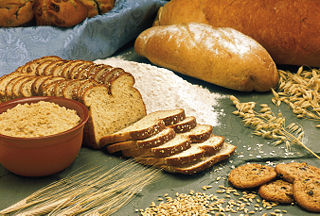
Porridge is a food commonly eaten as a breakfast cereal dish, made by boiling ground, crushed or chopped starchy plants—typically grain—in water or milk. It is often cooked or served with added flavorings such as sugar, honey, fruit or syrup to make a sweet cereal or mixed with spices or vegetables to make a savoury dish. It is usually served hot in a bowl.

Corn flakes, or cornflakes, are a breakfast cereal made by toasting flakes of corn (maize). The cereal was created by John Harvey Kellogg in 1894 as a food that he thought would be healthy for the patients of the Battle Creek Sanitarium in Michigan where he was superintendent. The breakfast cereal proved popular among the patients and the Kellogg Company (Kellogg's) was set up by Dr. John's brother, Will Kellogg, to produce corn flakes for the wider public. A patent for the process was granted in 1896.
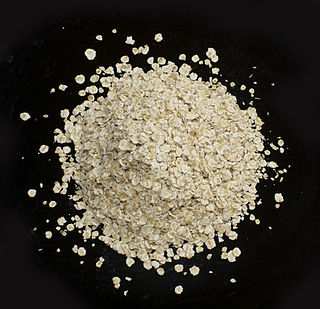
Oatmeal is a type of coarse flour made of hulled oat grains – groats – that have either been milled (ground), steel-cut, or rolled. Ground oats are also called "white oats". Steel-cut oats are known as "coarse oatmeal" or "Irish oatmeal" or "pinhead oats". Rolled oats can be either thick or thin, and may be "old-fashioned", or "quick", or "instant". The term "oatmeal" is also used in the U.S. and parts of Canada as another word for an oat-based porridge popular in such countries made from either ground, steel-cut, or rolled oats.
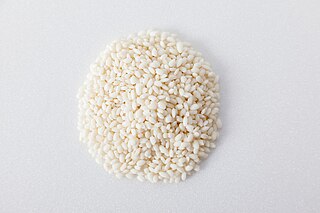
Glutinous rice is a type of rice grown mainly in Southeast and East Asia and the eastern parts of South Asia, which has opaque grains, very low amylose content, and is especially sticky when cooked. It is widely consumed across Asia.

Tahini is a condiment made from toasted ground hulled sesame. It is served by itself or as a major ingredient in hummus, baba ghanoush, and halva.

Muesli ; Swiss German: Müesli[ˈmyəsli], non-Swiss Standard German: Müsli [ˈmyːsli] ) is a cold breakfast cereal dish based on rolled oats and ingredients like grains, nuts, seeds and fresh or dried fruits. This mix may be combined with one or more liquids like milk, almond milk, other plant milks, yogurt, or fruit juice and left for a time to soften the oats before being consumed. The cereal is served cold.
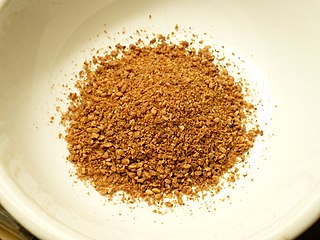
Gomashio is a dry condiment, similar to furikake, made from unhulled sesame seeds and salt. It is often used in Japanese cuisine, such as a topping for sekihan. It is also sometimes sprinkled over plain rice or onigiri. Some commercially sold gomashio also has sugar mixed in with the salt.

Laddu or laddoo are sphere-shaped sweets originating from the Indian subcontinent. Laddus are made of flour, ghee/butter/oil and sugar, with other ingredients that vary by recipe, like chopped nuts or dried raisins. They are often served at festive or religious occasions.

Gofio is a sort of Canarian flour made from roasted grains or other starchy plants, some varieties containing a little added salt. Gofio has been an important ingredient in Canarian cooking for some time, and Canarian emigrants have spread its use to the Caribbean and the Western Sahara. It is also found in Argentina, Uruguay, and Chile, where it is known as harina tostada and is employed in a wide variety of recipes. The gofio commercially available in the Canary Islands is always finely ground, like ordinary flour, despite the definition given in the Spanish Dictionary of the Royal Academy.

Iraqi cuisine or Mesopotamian cuisine has a long history going back some 10,000 years – to the Sumerians, Akkadians, Babylonians, Assyrians, and ancient Persians. Tablets found in ancient ruins in Iraq show recipes prepared in the temples during religious festivals – the first cookbooks in the world. Ancient Iraq, or Mesopotamia, was home to a sophisticated and highly advanced civilization, in all fields of knowledge, including the culinary arts. However, it was in the Islamic Golden Age when Baghdad was the capital of the Abbasid Caliphate (750–1258) that the Iraqi kitchen reached its zenith. Today, the cuisine of Iraq reflects this rich inheritance as well as strong influences from the culinary traditions of neighbouring Iran, Turkey and the Syria region area.
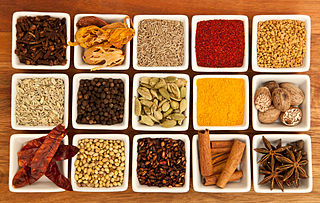
The cuisine of Karnataka includes many vegetarian and non-vegetarian cuisines. It is one of the oldest surviving cuisines and traces its origin to the Iron Age. Ragi is mentioned in the historical works of the great poet Adikavi Pampa and in the ancient Sanskrit medical text Sushruta Samhita. The varieties of the Karnataka cuisine have drawn influence from and influenced the cuisines of neighbouring states like Tamil Nadu, Andhra Pradesh and Kerala. Although the ingredients differ from one region to another, a typical Kannadiga Oota includes the following dishes in the order specified and is served on a banana leaf: Uppu (salt), Kosambari, Pickle, Palya, Gojju, Raita, Payasa (Kheer), Thovve, Chitranna, Anna (rice), and Tuppa (ghee).

Black sesame soup is a popular east-Asian and Chinese dessert widely available throughout China, Vietnam, Taiwan and Singapore. It is typically served hot. In Cantonese cuisine it takes the form of tong sui, or sweet soup, with greater viscosity. The main ingredients are black sesame seeds, rice and water. Sugar is added for sweetness. Tangyuan is sometimes added into black sesame soup. Black sesame soup can be purchased in powder form.
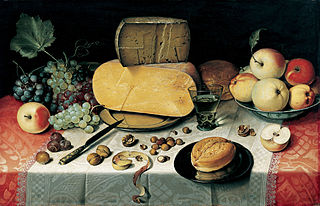
Jolpan, or snacks, are often served at breakfast in the Cuisine of Assam, although they may also be served at Bihu festivals or weddings. The word jolpan includes all the preparations namely jolpan, pitha, laru and tea. Other common jolpans served for breakfast may include roti, luchi, ghugni and sometimes paratha etc. Jolpan are also found in Bengal. The word literally derives from "water and betel leaf" but can mean any snack.
Palathalikalu is an Indian sweet dish made during Sankranthi in the Delta region of Andhra Pradesh, India.

Misu (미수) is a beverage made from Korean traditional grain powder, misu-garu which is a combination of 7–10 different grains. It is usually served in the hot summer days to quench thirst or as an instant nutritious drink for breakfast or as a healthy snack.

Chadian cuisine is the cooking traditions, practices, foods and dishes associated with the Republic of Chad. Chadians use a medium variety of grains, vegetables, fruits and meats. Commonly consumed grains include millet, sorghum, and rice as staple foods. Commonly eaten vegetables include okra and cassava. A variety of fruits are also eaten. Meats include mutton, chicken, pork, goat, fish, lamb and beef. The day's main meal is typically consumed in the evening on a large communal plate, with men and women usually eating in separate areas. This meal is typically served on the ground upon a mat, with people sitting and eating around it.

Congee or conjee is a type of rice porridge or gruel popular in many Asian countries. When eaten as plain rice congee, it is most often served with side dishes. When additional ingredients such as meat, fish, and flavorings are added while preparing the congee, it is most often served as a meal on its own, especially for persons who are ill. Names for congee are as varied as the style of its preparation. Despite its many variations, it is usually a thick porridge of rice largely disintegrated after prolonged cooking in water.





